Share article:
Text marketing: How to deliver engaging SMS campaigns

Whether you’re a big brand or a small business, connecting with today’s consumers means reaching them on their mobile devices. Text marketing is a simple and effective method for delivering SMS and MMS messages at scale. Plus, it’s an engaging, personal way to communicate with customers.
But if you’re new to text message marketing, where do you start? In this guide, we’ll explain all the details so you can decide how to come up with a strategy that works for your audience, budget, and business goals.
What is text marketing?
Text marketing is a strategic approach to sending targeted SMS or MMS messages to a group of recipients. Text message campaigns can be informative or promotional. They can also be personalised, conversational, and include automated responses. That’s what makes SMS marketing a highly engaging form of two-way communication between a customer and the sender.
While typical text messaging is P2P (person to person or peer to peer), text campaigns are A2P (application to person). The biggest difference is that A2P messaging is sent through a text marketing service like Sinch MessageMedia while P2P messages go directly between phones.
Text marketing protocols: SMS and MMS
There are two basic types of messages for text marketing: SMS and MMS. A third option is RCS or Rich Communication Services, which enables rich text messaging experience similar to messaging apps like WhatsApp or Messenger. However, RCS is currently only available on Android devices and hasn’t been rolled out globally yet. For now, however, the MMS and SMS protocols can cover the majority of your mobile marketing needs.
SMS stands for Short Message Service. A single SMS message is limited to 160 characters – or just 70 if it includes an emoji or other type of Unicode character. That’s where the “short” comes from. An SMS campaign can contain more than 160 characters, but it will be sent as a multi-part message and reassembled as one on the recipient’s device. That’s why you’ll need to keep SMS campaigns clear and concise. So, pay attention to text message character counts.
An MMS marketing campaign offers more flexibility and can include up to 1600 characters. MMS stands for Multimedia Message Service, and as the name suggests, it supports delivery of media such as images and videos. Here’s a visual example of the difference between MMS and SMS campaigns:
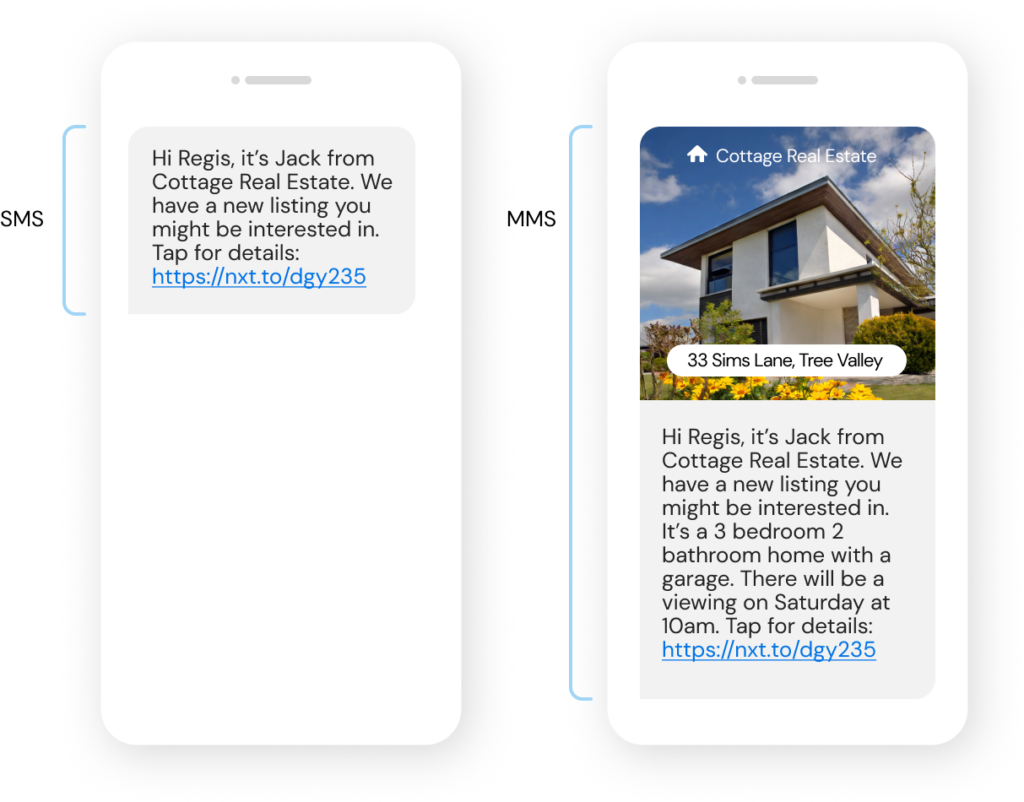
MMS and SMS campaigns help deliver all sorts of messages and information. Of course, you’ll want to have a specific purpose and goal for every campaign so it’s clear what you expect to achieve and so you can measure your success.
8 types of text marketing campaigns
Text campaigns serve many purposes and enhance communications connected to the customer experience. For example, there are multiple ways to use transactional SMS to deliver important details to individuals. That includes order confirmations, fraud notifications, delivery updates, password resets, and two-factor authentication (2FA).
In this article, we’ll focus more on bulk text message campaigns that send information and promotions to groups of people. Here are some of the common ways businesses use text marketing.
1. SMS opt-in campaigns
You may already have a database that includes mobile phone numbers for customers and contacts. However, before you start sending promotional text messages, you need to get permission from those people. That’s where an SMS opt-in comes in.
These are simple campaigns in which contacts send a standard reply to a message that asks them to opt in and receive more messages. For example, an opt-in request for text marketing messages might read like this:
Business X wants to send you texts about our deals and discounts. You may receive up to 3 messages/week. Reply “YES” to subscribe. “STOP” to opt out.
This method also works well for double opt-ins. That’s when, for example, someone signs up for promotional texts at an event or point-of-purchase, but you still want a digital record of their consent.
While you may have inferred consent to text customers, the type of campaign as well as regional rules and regulations could also require you to obtain explicit consent. No matter what laws you must follow, getting permission is always a good practice.
2. Exclusive offers and updates
Once you’ve received an appropriate level of permission, you can use SMS campaigns to drive more awareness, website traffic, and sales. Text messaging campaigns that highlight special offers are an effective way to engage consumers and even to increase signups.
Research from Sinch Mailjet found 24% of consumers primarily sign up for texts from a brand to get a one-time discount while another 22% opt in to receive regular offers. So, text marketing is a good way to promote and distribute coupon codes.
Text marketing works especially well for things like flash sales. That’s because texts are a good way to get your message out and get responses quickly.
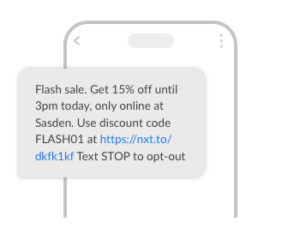
SMS campaigns are perfect for encouraging immediate action because response rates are much higher than on channels like email or social media ads. SMS open rates are as high as 98%, and 90% of messages are viewed within the first few minutes of delivery.
Here’s how a personalised MMS campaign promoting a sale at an online store might look. This type of text marketing can include imagery to enhance the experience and showcase what’s on sale.
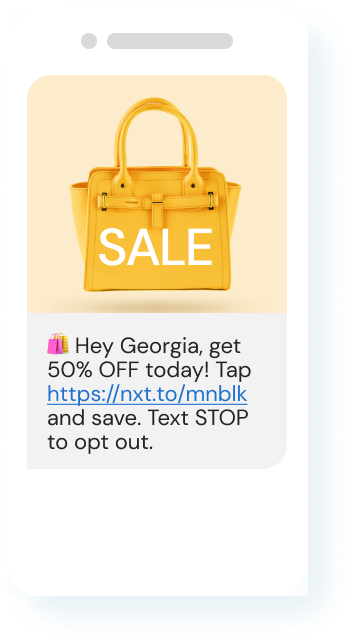
3. Cart abandonment SMS campaign
An SMS campaign can also be used to bring shoppers back to your website. If you run an e-commerce business or online store, cart abandonment solutions are an ideal way to capture revenue you’re losing.
A cart abandonment text message may read like this:

Service providers like Sinch MessageMedia make it easy to integrate with popular ecommerce platforms like Shopify and BigCommerce to simplify cart abandonment campaign execution.
Try it out for yourself
Start a 14-day free trial and see how text marketing can help grow your business

4. SMS notifications and reminders
Besides abandoned cart messages, there are many other types of marketing reminders for which SMS is an ideal communication channel.
Appointment reminders can help some businesses while others may want to keep an audience informed about upcoming events. SMS reminder campaigns often deliver specific, personalised information to individuals, but they can also provide updates to your entire customer base.
For example, here’s an SMS reminder for Mother’s Day shoppers.
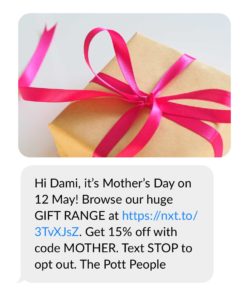
Text message reminders are useful for both customers and businesses. And they can go beyond just reminding someone to shop for a special occasion. Appointment reminders that you sent via SMS reduce no-shows and keep business running smoothly while making people feel valued.
5. Customer feedback and surveys
Another way to make people feel valued is to use SMS to ask for their opinions.
Text messaging campaigns are a practical way to follow up with customers and request a review of your products or services. You can also send SMS messages asking for specific feedback.

This is a great way to collect information that helps you improve everything from product development and in-store experiences to customer service and more. You can either send recipients to a web page or use an automated sequence to get feedback via SMS.
SMS campaigns can even be used to collect first-party data for insights that support efforts such as segmentation and personalization. If all you have is a phone number, you can request additional information about the contact via text – one question at a time.
The example below shows how The Chambers restaurant uses Sinch MessageMedia’s SMS templates to request ratings from diners and encourage more positive online reviews.
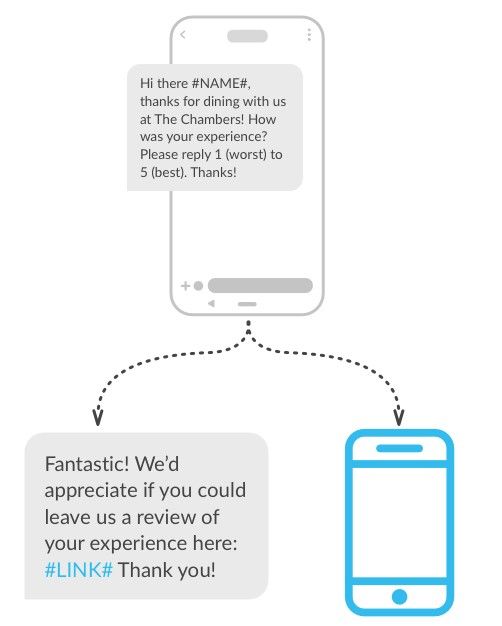
Allowing customer to rate their experience via text messages has not only increased the number of positive reviews, but also given the team valuable insights.
6. Keyword campaigns
SMS keywords are one-word terms consisting of letters and/or numbers that people use to request information or to sign up. As we saw in the first example, you can use a keyword to facilitate SMS opt ins and opt outs. But they can do more than that…
Brands use SMS keywords for a wide variety of text marketing campaigns. It could be to subscribe to a drip campaign that sends weekly tips to customers. It could be a keyword used to receive an exclusive discount. Here’s a text marketing example featuring a keyword used to join a VIP program.

SMS keyword campaigns are usually connected to autoresponders, which allow you to reply almost instantly to requests from recipients who use the keyword. SMS keywords also help with compliance because they are a clear signal that someone is opting in to receive the texts.
7. Loyalty and reward campaigns
The point of launching a rewards program is to create loyal, repeat customers. Once people sign up, you can use text marketing campaigns to increase the chances of customers returning and reduce the risk of churning.
Consumers will view personalised updates as helpful reminders, and they’ll be prompted to take advantage of the rewards program, which is good for your business. Here’s how a message could look.
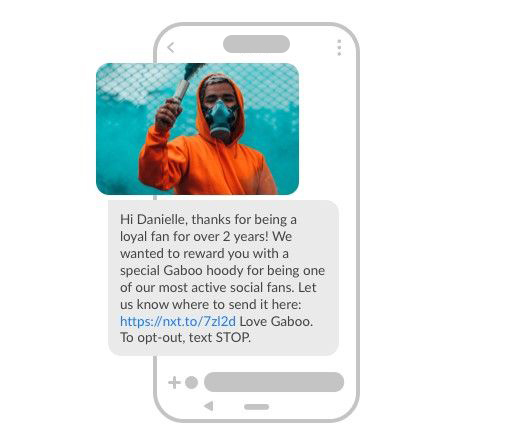
Personalise SMS loyalty campaigns even further by delivering special rewards and incentives for customers’ birthdays or other milestone moments.
8. Informational SMS campaigns
There will also be situations where you’ll want to send a bulk text message that isn’t necessarily related to boosting sales. For example, during the COVID-19 pandemic, many organizations needed to communicate important safety updates or news of closures to customers.
Of course, it won’t always be urgent. It may be an SMS campaign that simply informs customers about seasonal hours of operation.
Or, you could even use SMS alerts to communicate important information to staff, parents, and students. For instance, schools or teachers can send out low grade alerts to parents to help them improve their children’s performance.
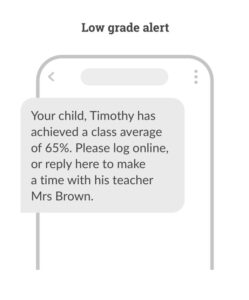
The point is, SMS communication is a helpful way to quickly and efficiently deliver time-sensitive messages to the people you serve.
What makes a good text marketing campaign?
To get the most out of every text message campaign, your strategy should focus on three simple words: anticipated, personal, and relevant. Marketing expert, Seth Godin, used those words in his 1999 book Permission Marketing to describe effective brand communication in the digital age.
While Godin was mainly writing about email marketing back then, the book’s lessons still apply to mobile marketing. Here’s how it works with text marketing:
- Anticipated: Be sure to define clear expectations for what you’ll send and how often you’ll text people. When someone gives you permission to contact them, they’ll be anticipating your messages. Automated SMS replies happen in real time, which means no waiting for a brand or representative to respond.
- Personal: SMS already feels personal because texting is a common form of peer-to-peer communications. Enhance that feeling with conversational campaign copywriting and by personalizing your text marketing.
- Relevant: Respect recipients who gave you permission to text them. Only send the types of SMS campaigns they signed up for and do your best to deliver messages that resonate with them. Find ways to segment SMS subscribers to increase the relevancy of your campaigns.
It may be helpful to imagine you’re in a dating relationship with your customers. That’s another lesson from Permission Marketing. How would you use SMS if you wanted to maintain a relationship? If you overwhelm people with messages, bore them, or even ghost them, you’re going to get dumped.
Ready to try out SMS marketing?
Take Sinch MessageMedia for a spin to see how it can benefit your marketing strategy.

5 things you need to run a text campaign
Now that you’ve got some ideas for how your business could take advantage of text message marketing, let’s explore some of the things you need before you start sending texts to customers and prospects.
1. Find a service provider
First things first, you’ll need to choose an SMS service provider that can offer a platform equipped with all the tools and options you’ll need. A text marketing service may also be called an SMS aggregator or SMS gateway, and it’s what connects your brand to the mobile carriers serving your contacts.
Here are a few key considerations:
- The provider’s network: A tier-1 network is going to give you the widest reach along with many other benefits. Tier-2 networks often only operate in specific regions, and tier-3 networks often have to pay tier-1 networks. Tier-1 is the most direct route and may also be called a super network because of its breadth and power.
- Speed and scalability: Ideally, you’ll find a provider with high delivery rates and low latency for reliable performance. Will the provider be able to handle increasing volumes as you grow? Can it support incoming (two-way) messages? You may also want an option that lets you expand into other channels.
- Security and compliance: Make sure you understand regulations for SMS communication wherever you’re doing business. Do due diligence to find out if a potential SMS provider helps you comply with laws and protects consumer data.
- Reporting and analytics: Find out how an SMS provider helps you track and measure the success of your campaigns. The more details you can access, the more insights you’ll have for success in the future.
- Ease of integration: Will your SMS provider be able to connect with other business applications such as a customer relationship management (CRM) platform or ecommerce solution?
The ability to easily integrate with existing software solutions is a critical consideration. As you’re probably already using effective tools for your marketing campaigns, you don’t want to go back and forth between tools. This is especially true when you’re going for a multichannel approach where you work with multiple channels to optimise your reach.
For example, when the Australian online wine retailer Vinomofo wanted to use text campaigns to reduce churn, they needed to integrate SMS with Hubspot because that was the tool they were already using successfully for their email campaigns. Find out how they did it.
2. Choose a phone number and SMS sender ID
There are a few different types of numbers you can use to run SMS campaigns. Here are the basics on each type:
- Toll-free numbers: SMS-enabled toll-free numbers are 10 digits long and can be used for marketing. You may be able to use an existing 1-800 number (or other prefix) if your business has a recognizable option. Throughput for toll-free numbers is lower at around 30 messages per second (mps), but they’re also the most affordable option.
- Dedicated short codes: Dedicated short codes are five to six-digit numbers that belong to one business. In Australia, dedicated short codes exist, but they come with high costs and compliance requirements, which has led to the popularity of free to text Virtual Mobile Numbers (dedicated numbers) as the short code alternative that most businesses use. Virtual numbers are also known as 10DLC numbers or long code.
- 10DLC numbers: A 10-digit long code is formatted like a typical phone number, including an area code. In Australia, and many other countries, these long code numbers are ten digits long, but there are countries where this might be different.
To learn more about these numbers, dive into the details of long codes vs short codes for SMS communications.
In addition to the number, you’ll need a verified SMS sender ID, which is the name that appears in the text identifying you as the sender. Don’t worry too much about all of this. A reliable text message marketing service should help you get everything set up.
3. Pre-register your
In 2022, the Australian Communications and Media Authority (ACMA) introduced the Scam Code. This industry code establishes “processes for identifying, tracing, blocking and otherwise disrupting Scam Calls and Scam SMS”. Part of these regulations require businesses to pre-register their alphanumeric sender IDs.
You can do this through your business SMS provider like Sinch MessageMedia.
4. Build a list of contacts
After you’re all set up on the technical side of things, it’s time to prepare and grow the list of numbers you’ll send SMS marketing messages to. As we’ve already made very clear, obtaining consent to text people through some form of opt in is crucial.
Offering incentives and running text-based contests are two convincing ways to get consumers to give you permission to send them SMS marketing campaigns. Check out our article on how to grow an SMS contact list for more ideas and advice.
5. Create SMS campaign templates
As your text message marketing strategy matures, you’ll find more ways to use SMS to improve communications and marketing efforts. Having SMS templates for different scenarios helps you save time and move quickly.
These templates are pre-written, pre-defined messages you keep on hand to use whenever necessary. Sinch MessageMedia offers a comprehensive collection of SMS templates for various industries that you can use to get started.
Text message marketing compliance
The main laws that handle SMS regulations and best practices in Australia are:
However, if you have customers in other regions, you might also need to follow local guidelines like the TCPA in the US, the European Union’s General Data Protection Regulation (GDPR) or the Data Protection Act in the UK. In New Zealand, there’s also the Unsolicited Electronic Messages Act 2007.
It’s a lot to consider, but many of these regulations have similar requirements. Once again, a good text marketing service will help you understand and follow the laws relating to consumer privacy and data protection. It’s your job to choose a trustworthy provider.
Here are some of the most important SMS compliance practices to follow:
- Always obtain proper consent before texting contacts.
- Provide an easy way to opt out of your text marketing and honor all requests.
- Do not use public or free link shorteners in text marketing.
- Only link to your own website/domain.
- Avoid using ALL CAPS in messages.
- Display clear, unambiguous calls to action (CTAs).
For more in depth details of SMS guidelines, visit our resource on SMS Compliance and Best Practices.
How to track text message campaigns
Once your text marketing campaigns are out in the wild, you’ll want to know if they’re working. Your provider should have some sort of analytics dashboard you can review.
These are some of the most important SMS marketing metrics to track:
- Delivery rate: The percentage of messages that reach subscribers’ devices. This helps you understand a campaign’s reach.
- Opt-out rate: The percentage of recipients who unsubscribe after receiving a specific campaign. This helps you understand if relevant content is being sent to contacts.
- Response rate: An engagment metric that measures replies to an SMS campaign. The average SMS response rate is 45%.
- Number of inbound messages: A metric for sales and customer service that measures how often people reach out to you via SMS.
- Click-through rate: The percentage of recipients who clicked the link in your message. This is an important engagement metric that shows interest in the SMS campaign.
- Conversion rate: The percentage of SMS recipients who completed a desired action such as making a purchase, viewing a video, or responding to a survey.
Marketing, sales, and customer service will have different goals for text messaging campaigns. So, it’s important to choose the right metric when determining the best way to measure success. Get more information in our article on SMS analytics.
Moving beyond SMS to omnichannel marketing
Text message campaigns are a great way to get started with mobile marketing, but SMS is far from the only way to reach people. There are other channels and protocols to consider for your marketing mix.
Your goal should be to connect with your target audience on whatever channels they prefer while providing a seamless customer experience across those channels. That’s omnichannel communications.
Here are some brief descriptions of other ways to reach people with your messages:
- MMS: Multimedia Messaging Services enable senders to deliver more than just basic texts. Send videos, images, and more to increase engagement.
- RCS: Rich Communication Services create an interactive, app-like experience inside text messaging inboxes. It’s an emerging protocol meant to eventually replace SMS and MMS.
- Mobile messaging apps: Services such as Messenger and WhatsApp are popular and represent effective channels for direct brand-to-consumer communication.
- Email marketing: A traditional option that remains an important way for brands and consumers to connect through transactional and promotional messages.
- Voice: An ideal channel for informational messages and for automating customer support through technology such as Interactive Voice Response (IVR).
As your business grows, your digital communication strategy should expand and mature along with it. The benefit of starting with text marketing is that it’s easy to get going and represents a channel that is available on nearly every mobile phone across the globe.
Show off your brand with MMS messaging
Send eye-catching visuals with MMS to boost engagement and grab your customers’ attention.
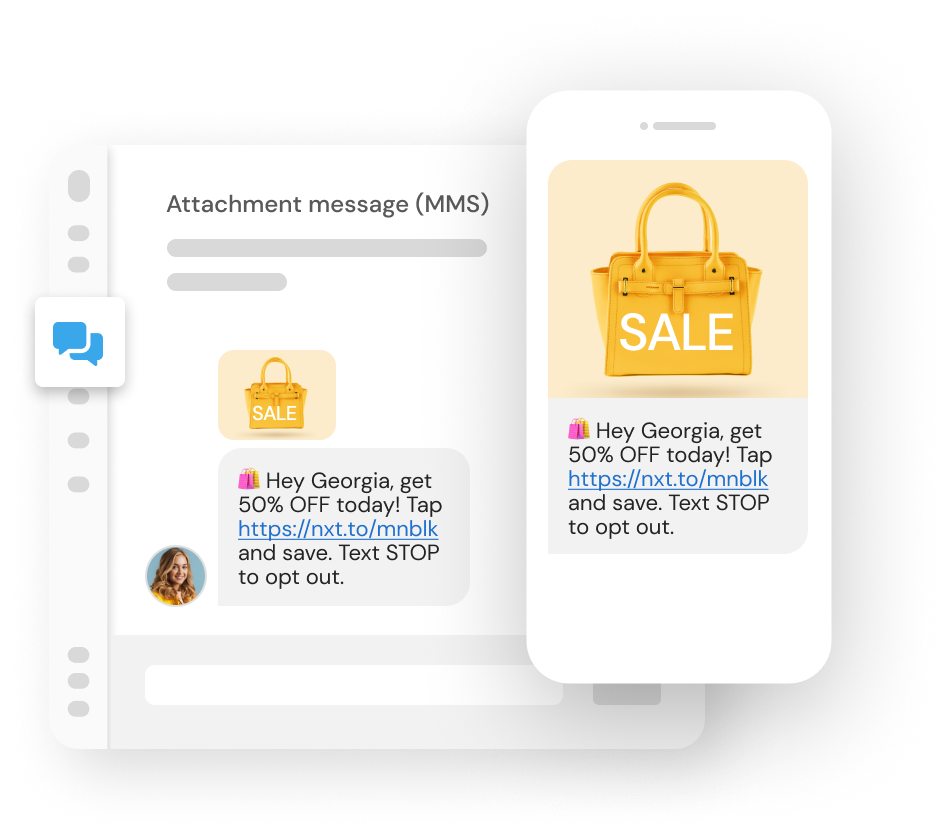
Get started with text marketing today
When you’re ready to begin exploring what’s possible with SMS and MMS marketing campaigns, Sinch MessageMedia is ready to help.
You can take advantage of a free trial for 14 days (no credit card required). You can start out with a basic plan for SMS and MMS, and flexibly add additional channels as needed. All plans include a two-way messaging inbox and more than 5,000 connected apps.
Start today and get on the path to launching your first successful SMS campaign.
